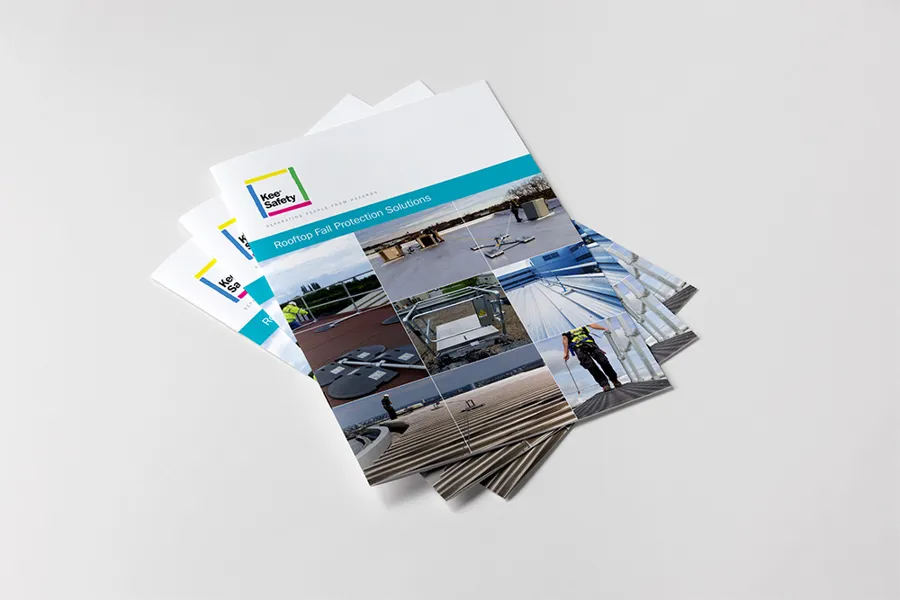
You are visiting the Canada Kee Safety website from United States. Would you like to go to the United States site?

Working on rooftops across Canada has many unique challenges. Yet, it also offers spectacular views and a boost in job satisfaction, team camaraderie, and bragging rights. Rooftop workers are a special breed who look out for one another’s well-being while they perform critical tasks under difficult conditions that others would shy away from.
However, working at height on rooftops remains one of the most hazardous activities across industries in Canada, as the risk of severe injury or a fatality due to a fall is ever-present. Employers must implement effective fall protection compliance systems that not only meet Canadian standards but also address specific rooftop hazards.
Whether you are looking at a simple system to provide access and egress over a roof joist or protecting a worker with a guardrail system around a leading edge, each system has site-specific design requirements and opportunities to provide a much safer area for workers to perform their tasks safely.
Here are six critical rooftop fall protection guidelines to help you protect workers, ensure regulatory compliance, and foster a safer, more productive workplace.

Unprotected roof edges are among the most obvious—and deadly—fall hazards. Installing non-penetrating guardrails provides a reliable fall protection system that does not compromise the roof membrane. Constructed of aluminum or galvanized steel for strength, durability, and corrosion resistance, these modular systems are ideal for flat or low-slope roofs and are installed without welding or drilling.
Roof guardrails must meet the fall protection system for Canada regulations and be visible and stable to maintain a secure perimeter. Guardrails are a preferred solution because they are “passive,” providing continuous, in-place protection for multiple workers without the need for special equipment or training.

The roof edge is the most obvious fall hazard on the rooftop; however, roof openings are often unwitting risks that need fall hazard prevention.
Access to the roof via a roof hatch is common, but if left unprotected, it is a serious risk in case of a trip or misstep. A roof hatch kit provides roof hatch safety by surrounding the hatch with a railing set that provides safe egress and ingress. It features a self-closing safety gate to protect the opening against a worker falling through. They are available to fit all standard roof hatches and securely clamp on without penetrating the roof.
Skylights are often mistaken for solid surfaces, but they can be fragile and not able to support the weight of even one worker. Furthermore, they can be obscured by snow and ice, presenting an unseen danger. Two types of strong, corrosion-resistant skylight protection systems provide fall protection compliance.

When guardrails are not feasible, “active fall arrest systems” are necessary, such as a horizontal lifeline rooftop system with compliant anchorages. Unlike passive fall protection compliance, active rooftop safety systems directly involve the user. They require training and regular inspections.
Horizontal lifelines allow mobility while providing travel restraint—so workers cannot reach a hazard—and fall arrest to minimize the impact of a slip and fall. Employees are secured to a stainless steel cable system that supports multiple workers in spans of up to 39 feet (11.9 metres) between anchorages. They are engineered for various roof types, including membrane, structure, and metal roof, and can also be installed overhead or mounted directly to concrete, steel, brick, or stonework.
Roof anchors are the backbone of a lifeline system, and according to federal, provincial, and territorial regulations, they must meet robust strength requirements and be installed by qualified professionals.

Traversing a rooftop can be challenging, especially when the surface is slippery from the elements or if the roof is uneven. Roof walkways feature anti-slip nylon treads set in corrosion-resistant frames for non-bounce stability. These steps are also self-draining to prevent the accumulation of water, snow, or ice. In addition to safeguarding workers, walkways also protect the roof from damage due to heavy foot traffic. For added fall protection, roof walkways can be fitted with guardrails or integrated into a horizontal lifeline system.
To overcome rooftop obstructions such as ducts, piping, conduits, and cables, a crossover platform is a specially designed walkway that enables workers to go up and over an obstacle. A modular system that can be tailored to the site-specific need, it features slip-resistant nylon treads, stable frames, and integrated guardrails. Crossover platforms can also bridge a gap or a change in the roof level.

Sometimes being on the roof is only the first step up. Servicing large HVAC units and other essential building services equipment may require reaching higher to access panels, controls, instruments, and the like. Ladders are inherently inefficient and often risky. For example, using a ladder at a heat exchanger near the roof perimeter can expose the worker to a deadly fall hazard even if the roof edge has compliant guardrails.
Modular work platforms are a safer and ergonomic alternative that are customized to the site-specific need. They feature the same slip-resistant treads used in walkways for steps and decks and are securely set in robust, durable, corrosion-resistant aluminum or galvanized steel frames with integrated guardrails. Types of work access platforms include:

Even the best equipment may be ineffective without trained workers. Every employee who performs tasks at height and their supervisor should complete certified fall protection training, such as:
Compliant, well-planned fall protection equipment in Canada is a legal requirement, and a path toward safeguarding valued workers who are ultimately more comfortable and productive. Investing in the right systems and certified training not only makes sense by preventing injuries, but also fosters a culture of safety, ensuring every worker returns home at the end of the day.

Kee Safety: Your Fall Protection Experts
Kee Safety is the world’s leading fall protection expert. We engineer, manufacture and install fall protection solutions that safely separate people from hazards. Our OH&S-compliant products and systems are third-party tested and trusted to ensure consistent performance at the highest level.